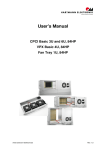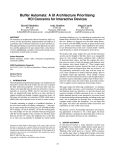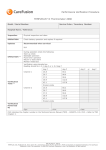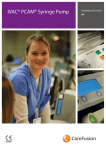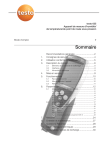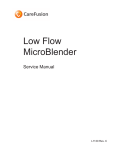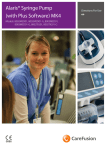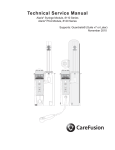Download Alaris® Pump module pressure measurement system
Transcript
Alaris® Pump module pressure
measurement system FAQs
October 7, 2011
Alaris Pump module
pressure measurement
system FAQs
®
Purpose: The purpose of this document is to provide general information and answers for clinicians
to the most frequently asked questions regarding the operation of the Alaris® Pump module Pressure
Measurement System.
1.
Exactly what pressure is being measured by the pump?
The Alaris Pump module Pressure Measurement System senses fluid pressure in
the IV set at the outlet or patient side of the pump. It estimates this pressure by
measuring force on the exterior of the IV tube wall much like we take a patient’s
pulse by pressing over an artery. If the pump is lower than the patient, the
pressure measured will be higher than that at the patient end of the delivery set.
2.
How does pressure change when a hard occlusion occurs?
If a hard occlusion occurs in the delivery path, pressure will build up in proportion to
the flow rate. When multiple sets are connected together or air eliminating filters are
present in the patient side of the delivery set, the rate of pressure build up is slowed.
3.
How is the hard occlusion pressure limit established for the Alaris
Pump module?
For each of the profiles or care areas, the hospital specifies one of two possible
occlusion detection modes. If the mode specified is Selectable Pressure, then a
numeric initial and maximum limit is entered.
When Selectable Pressure mode is specified, the maximum limit and default values
are set in mmHg from 50 to 525 mmHg. The default must be less than or equal to
the maximum.
When Pump mode is chosen, for flow rates at/above 30 mL/h, the limit is 525 mmHg;
between 10.1 and 29.9 mL/h, the limit reduces in proportion to flow rate, and remains
constant at 150 mmHg for flow rates of 10 mL/h and below.
In Selectable Pressure for limits below 200 mmHg and in Pump mode for flow rates
less than 30 mL/h, the pressure limit is set relative to the pressure measured at the
time Start is pressed.
© 2011 CareFusion Corporation or one of its subsidiaries. All rights reserved.
Alaris and Guardrails are trademarks or registered trademarks of CareFusion
Corporation or one of its subsidiaries.
Page 1
Alaris® Pump module pressure
measurement system FAQs
October 7, 2011
In all modes, when the measured pressure reaches the limit an alarm will alert the
clinician. This should not be confused with the pressure with which the device pumps
(see the following question).
4.
What determines how much infusion pressure is created when there is no
hard occlusion in the IV path?
With no hard occlusion, the pressure measured at the pump is determined by the
flow rate, the size and length of the delivery path, including catheter and the viscosity
of the fluid. Also, the patient’s venous or arterial pressure and the elevation of the
patient above the pump add to the total pressure measured by the pump. Movement
of the catheter within the vessel may create brief increases in pressure if the outlet
of the catheter is pressed against the vessel wall or valves.
5.
What should the hard-occlusion pressure alarm limit setting be?
While the range of pressure limits depends greatly on the application, we can say
this in general: the limit must be set higher than the greatest pressure expected to
be produced under normal (non-occluded) conditions. If it is not, there is a likelihood
of false alarm. Keep this especially in mind when infusing through small bore catheters
such as PICC’s (Peripherally Inserted Central Catheters). Higher gauge numbers have
smaller internal diameters, these catheters may require an increased downstream
occlusion alarm limit to potentially prevent false alarms).
6.
What pressure units are used to specify the hard-occlusion alarm limit?
The Alaris Pump module Pressure Measurement System uses millimeters of mercury
(mmHg) to specify pressure limits.
7.
What is the relationship between the pressure units millimeters of mercury
(mmHg), inches of water (inch-H2O), and pounds per square inch (psi)?
51.7 mmHg = 1 psi = 27.6 inchH2O.
8.
What are the Pressure Mode selections with the Alaris Pump module?
There are two pressure modes available to determine the patient-side occlusion limit
with the Alaris Pump module:
(Note that occlusion pressure limits are established in the data set {configured
for each individual care area or Profile} and are adjustable only in Selectable
Pressure mode.)
Pump mode, where downstream occlusion alarm threshold is 525 mmHg at flow rates
of 30 mL/h or greater. For rates less than 30 mL/h, the occlusion pressure is ratedependent, and the limit is relative to the pressure measured when Start is pressed.
This is to provide improved time response to hard occlusions.
Selectable Pressure mode, where the downstream occlusion alarm threshold can be
adjusted by the user in 25 mmHg increments from 50 mmHg up to the value set as
the profile’s Maximum Occlusion Pressure up to a maximum of 525 mmHg. Pressure
must reach hospital established pressure limit before occlusion warning will alarm.
For limits from 50 to 175 mmHg, the pressure limit is set relative to the pressure
© 2011 CareFusion Corporation or one of its subsidiaries. All rights reserved.
Alaris and Guardrails are trademarks or registered trademarks of CareFusion
Corporation or one of its subsidiaries.
Page 2
Alaris® Pump module pressure
measurement system FAQs
October 7, 2011
measured when Start is pressed. For limits of 200 mmHg and above, the limit
is absolute.
9.
What is Pressure Status Locked?
This is a profile system configuration setting that may be established for each
individual care area. When it is locked, the Pressure mode cannot be changed.
When it is unlocked the user may chose between Pump mode or Selectable mode.
For example, if the Pressure Status is unlocked, the clinician may switch between
Selectable and Pump modes. If it is locked, the profile designated Pressure Mode
is the only one that can be used.
10.
What is the default pressure for the Alaris Pump module?
With Selectable Pressure Mode in use, applicable to Guardrails® Suite MX version 9
software, this is the occlusion limit applied following initial power up or selection of
New Patient. The hospital may establish a default pressure setting for each profile
as a starting limit with the ability to increase the pressure limit up to the profile’s
maximum occlusion pressure limit.
11.
How can the clinician access the Pressure modes and adjust the pressure
limit on the Alaris Pump module?
1) Press Channel Select on the channel you wish to adjust the pressure limit or
Pressure mode.
2) Press Options.
Note: Current pressure limit listed in mmHg.
3) Under Pressure Limit Selection, press Selectable.
4) Press up or down.
Note: With each key press, the pressure limit will increase or decrease in
25 mmHg increments.
5) Once you have reached the desired new pressure limit, press Confirm.
Note: Change tick mark on pressure bar graph on main display for the channel.
12.
How does the Alaris Pump Module Dynamic Pressure display work and what
exactly is being displayed?
The Dynamic Pressure display provides a graphic display of the patient side
(downstream) pressure and the occlusion alarm threshold. It may be used to
view how close the line pressure is to reaching the occlusion alarm threshold
and/or whether the pressure is increasing or decreasing. The bar updates
approximately once each 10 seconds except when the pump is paused or
in alarm.
© 2011 CareFusion Corporation or one of its subsidiaries. All rights reserved.
Alaris and Guardrails are trademarks or registered trademarks of CareFusion
Corporation or one of its subsidiaries.
Page 3
Alaris® Pump module pressure
measurement system FAQs
October 7, 2011
Pressure is displayed using an open rectangular bar that extends from the left to the
right side of the screen, representing a range of 0–525 mmHg. The bar is filled in up
to a point, representing the downstream pressure reading.
In Selectable Pressure mode, for limits below 200 mmHg and in Pump mode at flow
rates less than 30 mL/h, the Occlusion Limit marker is placed on the bar relative to
the patient baseline pressure. Patient baseline pressure is the pressure measured
when Start was pressed. For example, as shown in the figure below, if the pump
measures 50 mmHg in the line when Start is pressed, and the limit is 100 mmHg,
the Alarm Limit is set at mmHg.
At higher limits in Selectable Pressure and in Pump mode at flow rates of 30 mL/h or
more, the limit marker is placed directly in relation to the bar graph 0-525 mmHg
range. For example, as shown in the figure below, in Pump mode at 50 mL/h, the limit
bar will be set to 250 mmHg (about at the horizontal center); this value is relative to
the left end of the pressure bar scale.
Note: On the device that the numeric VTBI (Volume To Be Infused) is displayed just
above the Dynamic Pressure display bar for each channel. There is no relationship
between the VTBI and the Dynamic Pressure display.
13.
When more than one pump module is running on the Alaris System, why is
the initial baseline pressure bar position and limit marker on the Pressure
Display sometimes different for each module?
• The horizontal position of the filled bar and the limit marker are affected by
four variables, each of which affects the total fluid pressure sensed in each line.
© 2011 CareFusion Corporation or one of its subsidiaries. All rights reserved.
Alaris and Guardrails are trademarks or registered trademarks of CareFusion
Corporation or one of its subsidiaries.
Page 4
Alaris® Pump module pressure
measurement system FAQs
October 7, 2011
• Previous infusion history of the line
• Fluid container height of each line relative to the pump
• Disposable pumping segment variables for each line
• Sensor variables on each channel
When any of these variables is different from one channel to the next, then
the initial baseline pressure displayed will appear different. See more details
in question 12 above.
14.
What should the clinician be looking at on the Pressure display to monitor
pressure changes in the line?
To monitor changes in the patient side pressure, the clinician should observe the range
(or space) between the current pressure reading (filled bar) and the occlusion alarm
limit marker (shown as the “current available pressure range to occlusion alarm” in the
diagrams in question 12). If this space is getting smaller, the pressure is increasing
and vice-versa. When the pressure bar reaches the occlusion alarm limit marker, an
occlusion alarm will be triggered.
15.
Can the current pressure reading be displayed as an actual numeric value?
While the Alaris Pump module software is internally calculating a numeric pressure
value at any point in time and displaying it visually as a filled bar on the Pressure
display, the actual numeric value is not currently presented on the Alaris PC unit
screen.
Since the only purpose of the Alaris Pump module Pressure System is detection of
“hard” occlusions, the precision numeric values are not needed. Further, at any time
the absolute pressure is subject to fluctuation variables including:
• Fluid container height of each line relative to the pump
• Disposable pumping segment variables for each line
• Sensor variables on each channel
• Infusion into different IV sites
• Flow rate of the channel or other channels connected in tandem
• Catheter dimensions
• Fluid viscosity
• Patient vessel pressure
• Fluid container elevation
A numeric pressure value may be misinterpreted given these variables. Instead, as
discussed in question 14 above, the intention is to visually track relative pressure
changes in the line, particularly whether it is increasing or decreasing. The user may
© 2011 CareFusion Corporation or one of its subsidiaries. All rights reserved.
Alaris and Guardrails are trademarks or registered trademarks of CareFusion
Corporation or one of its subsidiaries.
Page 5
Alaris® Pump module pressure
measurement system FAQs
October 7, 2011
observe whether the space between the filled bar and the occlusion alarm
limit marker on the bar graph is increasing or decreasing and take appropriate
response such as repositioning line, flushing, etc.
Since the full length of the pressure display bar represents 525 mmHg if the bar
were half-way filled, the pressure value from that channel would be roughly 250
mmHg. However, this is an estimate, which is subject to the variables above.
16.
Shortly after starting an infusion on the Alaris Pump module, why does the
Pressure display suddenly shift when there is no apparent change in the
infusion conditions?
After infusing approximately 0.4 mL after a door closure, or approximately 0.2 mL
after a fluid side occlusion alarm, the Alaris Pump module pressure measurement,
and thus the location of the filled bar and occlusion alarm limit marker, becomes
more accurate. This may show up as a small shift, or series of small shifts in the
Pressure display.
17.
What should the clinician do if the pressure bar and/or the occlusion alarm
limit marker are off the scale to the left and not visible?
If the current pressure reading (filled bar) and possibly the occlusion alarm limit
marker are off the scale to the left and not visible, depending on the infusion
settings, one or more of the following actions will tend to shift them to the right
into the visible area:
• Lowering the fluid container level relative to the pump
• Lowering the pump relative to the patient level
• Increasing the occlusion alarm limit if in Selectable Pressure mode
18.
Will the occlusion alarm limit “ratchet” up on the Alaris Pump module?
Under some the infusion settings, a limited degree of upward or downward auto
adjustment of the pressure limit occurs.
If operating in Pump mode with programmed rates less than 30 mL/hr or in Selectable
Pressure mode with occlusion alarm settings less than 200 mmHg, the Alaris Pump
module sets the baseline pressure each time Start is pressed to begin an infusion,
and sets the occlusion alarm limit relative to this baseline.
It is therefore possible for the baseline pressure and the occlusion alarm limit to
“ratchet” up over the course of several stops and starts. Using an example of an
infusion with a beginning patient side pressure of 20 mmHg and an occlusion alarm
limit of 100 mmHg, the baseline pressure would be set at 20 mmHg and the occlusion
alarm limit would be set at 120 mmHg. If the pressure rises over several hours to 40
mmHg and the infusion is stopped and then re-started again for some reason, the
system would measure the new baseline pressure as 40 mmHg and the alarm limit
would be set at 140 mmHg. The opposite is also possible; if the pressure were to drop
by 20 mmHg during an infusion and the infusion were stopped and then started again,
the baseline pressure and alarm limit would “ratchet” down. The occlusion alarm limit
is only allowed to “ratchet” up to a maximum setting of 525 mmHg.
© 2011 CareFusion Corporation or one of its subsidiaries. All rights reserved.
Alaris and Guardrails are trademarks or registered trademarks of CareFusion
Corporation or one of its subsidiaries.
Page 6
Alaris® Pump module pressure
measurement system FAQs
October 7, 2011
19.
The User Manual states that if the pump restarts more than the allowed time
in 10 minutes, it will alarm for a “partial occlusion.” How does the pump
“know” that a partial occlusion has occurred?
In fact, the pump neither “knows” whether partial or complete or full occlusions
have occurred. The pump only knows that the pressure in the line has exceeded
the prevailing limit. Since the most likely cause of elevated pressure is occlusion,
we conventionally describe the alarms as occlusion alarms. However, other factors
such as infusion into an arterial line, an ECMO circuit or other special applications
could create pressures above the set limits.
In the case of the so called partial occlusion, a likely cause of frequent restarts
is a partial occlusion such as would be caused by a catheter intermittently being
obstructed due to motion of the patient. However, other sources such as stopcocks,
other pumps infusing through a common catheter, etc., may create this alarm.
Due to the fact that policies, procedures and current clinical practices of hospitals are
extremely specific to the philosophy of the institution, CareFusion does not recommend
any values for configuration settings with data set development. We can, however,
share what other hospitals anonymously have selected or established for their system
configuration settings applicable to specific patient care areas or profiles. If you are
interested in reviewing this information, please contact your CareFusion Clinical
Operations Project Manager or Clinical Consultant to submit an ad hoc report request.
To assist in data set development, these reports can be customized to answer specific
questions on system configuration settings.
© 2011 CareFusion Corporation or one of its subsidiaries. All rights reserved.
Alaris and Guardrails are trademarks or registered trademarks of CareFusion
Corporation or one of its subsidiaries.
Page 7







